
Rendezvous with History
The Aztec Club's Sesquicentennial Tour
Teotihuacán
The Avenue of the Dead,
Pyramid of the Sun
and Palace of Quetzalcoatl
On Oct. 10, during our journey from Querétaro to Mexico City we stopped at the ruins of San Juan Teotihuacán, the most widely known and accessible of Mexico's major archaeological sites. Thought to have been founded as early as 700 B.C., archeologists estimate that at its height, in 500 A. D., up to 200,000 people lived in Teotihuacán making it bigger than Rome at that time and one the largest cities in the world.
Although it once counted more inhabitants then contemporary Rome, its citizens disappeared without a trace in 700 A.D. The name itself means "place where gods were born", echoing back the belief that the gods of the world created the universe here. The first known settlements in Teotihuacán Mexico were around 500 B.C. and the construction of the famous Teotihuacán Pyramid of the Sun began in about 100 B.C. The Teotihuacán Pyramid is the second largest in the New World (after the Great Pyramid of Cholula) and offers impressive views of the valley and ceremonial, "Avenue of the Dead" that open out below. Near the Teotihuacán Pyramid of the Moon is the Palace of Quetzalcoatl, which we also viewed.

Plan of the Ciudadela Court at Teotihuacán
The main axis of Teotihuacán is the Avenue of the Dead, running approximately north-south. The center of the city would be just in front of the great square enclosure known as the Ciudadela or Citadel. The Ciudadela is basically a broad, sunken courtyard surrounded by symmetric platforms, which contains near its center the imposing Temple of the Feathered-Serpent (Quetzalcoatl). This great square enclosure was probably the royal palace. Recent investigations have revealed two apartment complexes which probably were seats of royal authority (quite possibly there could have been dual rulership, which some have suggested for the later Aztecs).
To see an aerial view of the Teotihuacán archaeological site in a new window, click here.
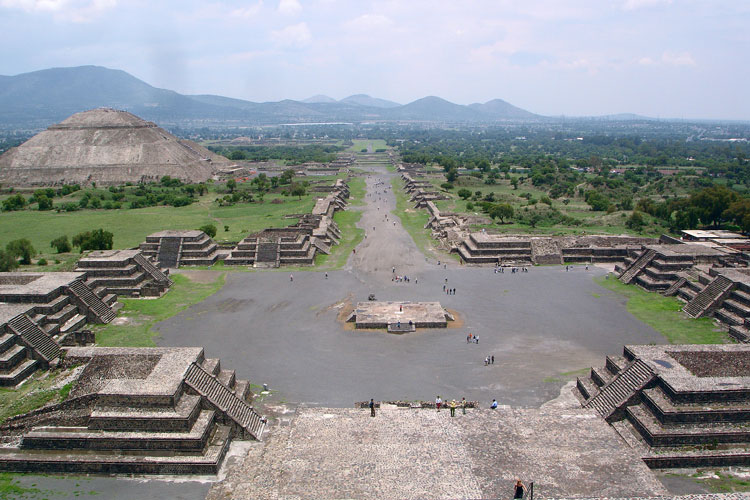
Avenue of the Dead and Pyramid of the Sun seen from Pyramid of the Moon

Plaza of the Moon, Avenue of the Dead and Pyramid of the Sun
The view of the Plaza of the Moon reveals one of the most symmetric and beautiful architectural compounds in the history of world art. From it starts the Avenue of the Dead and in the background the Pyramid of the Sun can be seen. The setting of mountain and pyramid is visually compelling at Teotihuacán, as if humans sought to place their works in perfect harmony with the landscape. Intersections of such striking topography formed portals to the sacred in ancient Mesoamerica, points of minimal transformation, and the Teotihuacános made the most of them, focusing cults on mountains and caves and celebrating them with architecture.
Unlike elsewhere in Mesoamerica, where people lived in cities surrounded by villages and hamlets, in the Teotihuacán area almost the entire population lived in the city. All cities in Mesoamerica were aligned astronomically, and Teotihuacán was planned so that its "north" was 15.25 degrees east of true north.
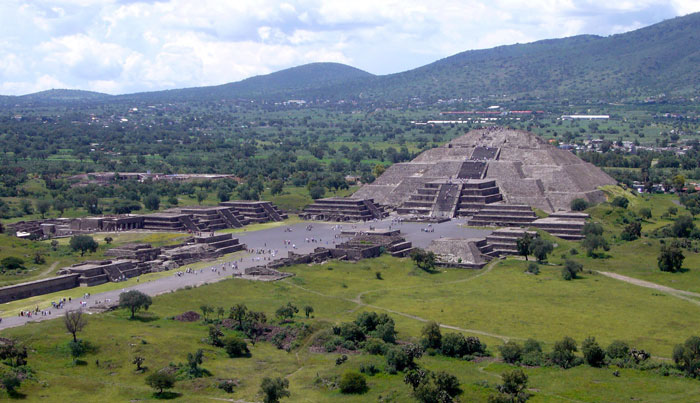
Pyramid of the Moon

Avenue of the Dead, Teotihuacán
In the city of Teotihuacán there is a broad avenue, now named the Avenue of the Dead. It is more than 40 meters wide and 3 kilometers long. Crossing the San Juan River, where a wide bridge must have stood, the avenue follows the natural rise of the terrain until it reaches the Pyramid of the Sun. In this section the avenue forms a series of horizontal patios joined by transverse stairways that compensate for the incline of the terrain. The extreme north end of the avenue opens into an enormous esplanade known as the Plaza of the Moon. It is believed that some of these "sunken patios" that are located along the Avenue of the Dead were used as ball game courts.
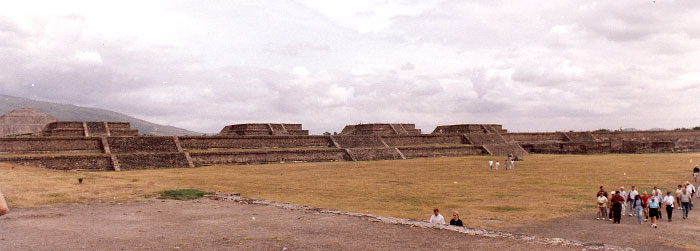
The unique Talud-tablero architectural style consists of
a platform structure, or the tablero, on top of a sloped talud.
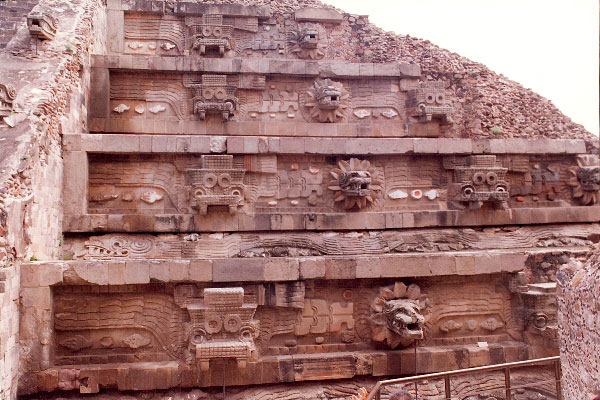
Feathered Serpent and Tlaloc masks project from the facade of the Quetzalcoatl Pyramid.
On the eastern side of the inner plaza is the so-called Temple of the Feathered-Serpent (Quetzalcoatl), a six-tiered step-pyramid with typical talud-tablero fagades, constructed in the Early Classic period (100-700 A.D.) and partly covered by a later pyramid which abutted its western side. Its austere relief figures of Feathered Serpents alternate with Fire (war) Serpents, expressing the opposition between greens and life on the one hand, and hot, fiery desert on the other.
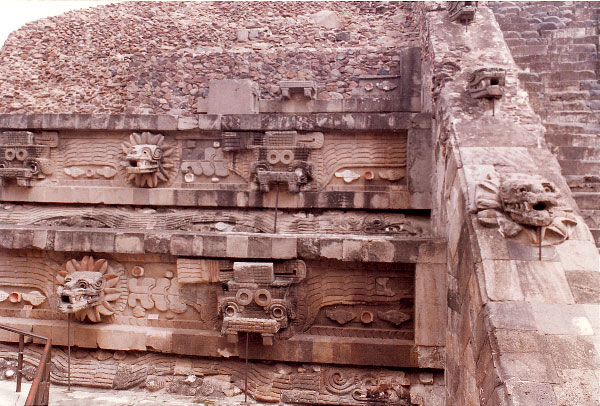
The stepped front facade of the Quetzalcoatl Pyramid
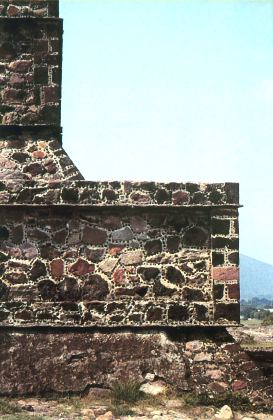
Platform detail

Palace at Quetzalcoatl
Off the southwest corner of the Moon Plaza is the sumptuous residential Palace of Quetzalcoatl (Quetzal butterfly), erected later in the history of the city. It was restored by the archaeologist Jorge Acosta.
We examined, up close and personal, the magnificent Pyramid of the Sun, on the east side of the Avenue of the Dead, which dominates the ruins. It is the oldest of the structures there. Several of us climbed the 248 arduous steps, up five steep sloping levels, to a height of more than 250 feet to see the magnificent view of the valley below.
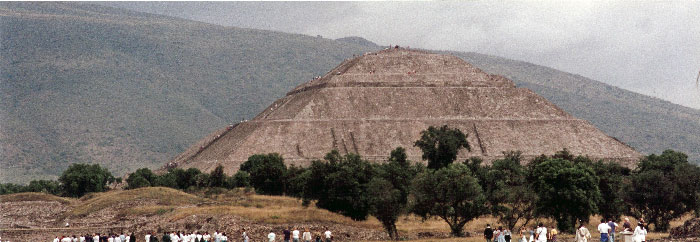
Pyramid of the Sun at Teotihuacán
The Pyramid of the Sun, is an ambitious monument of exceptional importance. Built between 100-700 A.D., it rests on a squared base, each side 215 meters wide. It is 65 meters high and consists of four stepped, slopped tiers. A stepped platform and stairway is on its western side. Smaller pyramids and temples are symmetrically placed around it, endowing the complex with extraordinary grandeur. The orientation of the Pyramid of the Sun is based on astronomical considerations, and like the Avenue of the Dead and all the structures in the city, it deviated only slightly from astronomical north. Underneath the Pyramid of the Sun there is a cave that was probably considered as the place of origin of the Teotihuacanos.

Gathering before the climb up the Pyramid the Sun
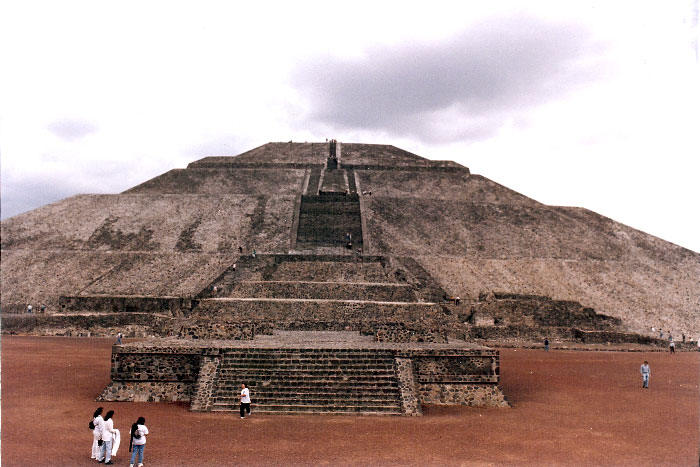
Grand Platform before the Pyramid of the Sun
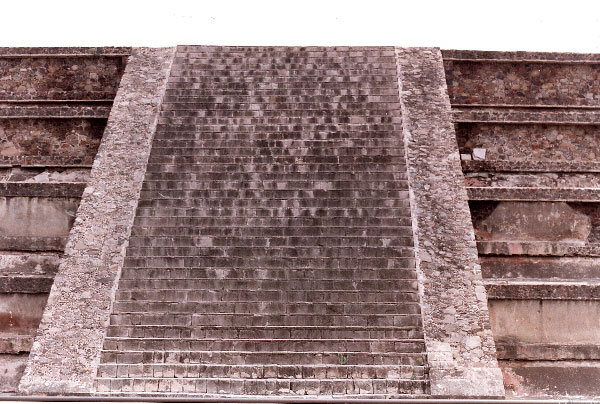
The steps at the base of the Pyramid of the Sun are the easiest to climb.

Only on approaching the second level of the Pyramid itself does one appreciate how steep and difficult the remaining climb will be.
Built of Adobe brick faced with volcanic stone, it is the third-largest such structure in the world. Each side of its base measures about 735 feet. When first discovered, the pyramid, actually known as a Teocali, appeared as a gigantic mound covered with vegetation. (See a related web page about the
Aztec Club's Teocali.)
We marveled at the achievement in erecting this structure as not only was it solid from wall-to-wall but it was built without benefit of the wheel or metal tools. From its peak we looked down upon the Pyramid of the Moon. We also saw in the distance the Palace of Quetzalpapalotl, which we had visited earlier in the day.
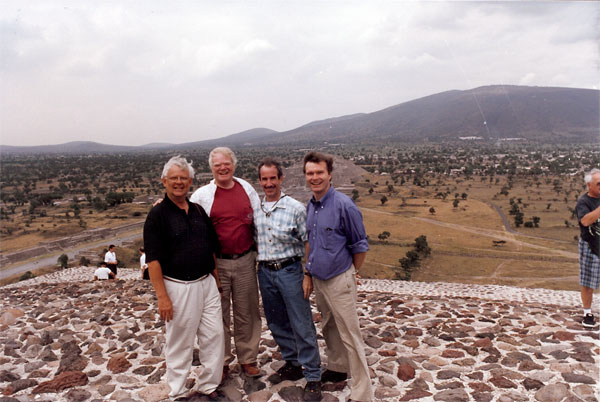
Four of us made it to the top of the Pyramid of the Sun.
(L to R: Williard Blankenship, William Wiseman Huss, Jr., Richard Hoag Breithaupt, Jr. and Worthington Peter Pearre)
|
![[Aztec Club Logo]](Aztec7.gif)
















